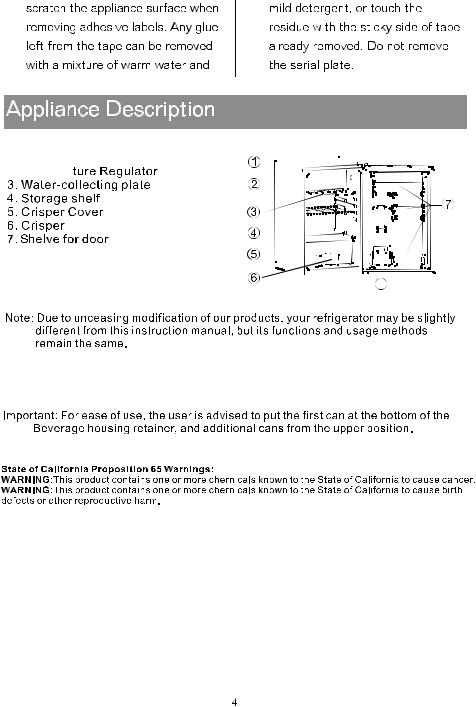HISENSE RS-17DL4SA, RS-17DC4SA, RS-17DC1HA User Manual

USER’S OPERATION MANUAL
MODE D’EMPLOI
RS-17DR1SS
User manual |
1 |
FR Manuel de I’utilisateur |
12 |

Contents
Important Safety Instruction_ _ _ _ __1 Installation_ _ _ _ _ _ _ __ _ _ _ _ __ _3 Appliance Description _ _ __ _ _ _ _ _4 Temperature Control_ _ _ _ _ _ _ _ __ 6
Cleaning and care_ _ _ _ _ _ _ _ _ __ _7 Energy Saving Tips_ _ _ _ _ _ _ _ _ _ _9 Trouble Shooting_ _ _ _ __ _ _ __ _ _ _9
Disposal of the appliance__________11
Important Safety Instructions
For your safety and correct usage, please read these instructions carefully before using your new appliance to avoid unnecessary mistakes and accidents. Please ensure that all people using this appliance are familiar with its operation and safety features. Keep these instructions in a safe place for future reference and be sure that they are kept with the appliance in the event that it is moved or sold, so that everyone using it through its life will be properly informed on its correct appliance usage and safety. The manufacturer is not responsible for damages caused by misuse. The appliance is for indoor and domestic use only.
Electrical Information
●The appliance must be plugged into its own dedicated 115 Volt, 60 Hz., 15 Amp, AC only electrical outlet.
The power cord of the appliance is equipped with a three-prong grounding plug for your protection against electrical shock hazards. It
must be plugged directly into a properly grounded three prong receptacle. The receptacle must be installed in accordance with local codes and ordinances. Consult a qualified electrician. Avoid connecting refrigerator to a Ground Fault Interruptor (GFI) circuit. Do not use an extension cord or adapter plug.
●If the power cord is damaged, it should be replaced by an authorized service technician to prevent any risk.
●Never unplug the refrigerator by pulling on the power cord. Always grip the plug firmly, and pull straight out from the receptacle to prevent damaging the power cord.
●Unplug the refrigerator before cleaning and before replacing a light bulb to avoid electrical shock.
●Performance may be affected if the voltage varies by 10% or more. Such damage is not covered under your warranty.
●Do not plug the unit into an
1

electrical outlet controlled by a wall switch or pull cord to prevent the refrigerator from being turned off
accidentally.
&.
- The appliance contains a small quantity of refrigerant (R600a)
which is environmentally friendly but potentially flammable in the refrigerant refrigerant circuit.
Safety for Children and Others
Who are Vulnerable
•This appliance is not intended for use by persons (including children) with a lack of experience and knowledge, unless they have been given supervision or instruction concerning the use of the appliance by a person responsible for their safety. Children should be supervised to ensure that they do not play with the appliance.
•Keep all packaging away from children to avoid risk of suffocation.
•If you are discarding your old appliance, pull the plug out of the socket, cut the connection cable (as close to the appliance as you can). Cut off the main plug and discard. Break off any old locks or latches as safeguard and remove the door to prevent children playing from suffering an electric shock or from closing themselves inside it.
Daily Use
•Do not store flammable gases or liquids inside the appliance. There
is a risk of an explosion.
•Do not operate any electrical appliances within the appliance (e. g. electric ice cream makers, mixers, etc.).
•When unplugging, always pull the plug from the main outlet. Do not pull on the cord.
•Do not place hot items near the plastic components of this appliance.
•Do not place food products directly against the air outlet on the rear wall.
•Frozen food must not be refrozen once it has been thawed out.
•Store pre-packaged frozen food in accordance with the frozen food manufacturer's instructions.
•The appliance's manufacturer storage recommendations should be strictly adhered to. Refer to the relevant instructions for storage.
•Do not place carbonated or fizzy drinks in the freezer compartment as it creates pressure on the container, which may cause it to explode, resulting in damage to the appliance.
•Popsicles can cause brain freeze if consumed straight from the freezer compartment.
•Do not place food directly against the air outlet inside the refrigerator.
•Do not place the appliance in direct sunlight.
2

Proper Disposal of your Refrigerator
Risk of Child Entrapment
Child entrapment and suffocation can occur when refrigerator is left unattended. Junked or abandoned refrigerators are still dangerous – even if they will sit for
“just a few days”. If you are getting rid of your old refrigerator, please follow the instructions below to help
preventInstallation
Before installing, follow these important first steps.
Location
Position the appliance away from sources of heat such as stoves, radiators, direct sunlight, etc. Maximum performance and safety are guaranteed by maintaining the correct indoor temperature for the class of unit concerned, as specified on the rating plate. This appliance performs well from 12.8 to 43.3 (55~110 ). The Appliance may not work properly if it is left for a longer period at a temperature above or below the indicated range.
! IMPORTANT !
There is a need of good ventilation around the fridge for easy dissipation of heat, high efficiency of refrigeration and low power consumption. For this
accidents.
Before you throw away your old refrigerator:
●Remove doors.
●Leave shelves in place so children may not easily climb inside.
●Have refrigerant removed by a qualified service technician.
purpose, sufficient clear space should be available around the fridge. It
is advisable for there to be 75 mm (approx. 3 inches) separating the back of the fridge to the wall, at least 100 mm (approx. 4 inches) of space at its two sides, and a minimum of 100 mm (approx. 4 inches) from its top and a clear space upfront to allow the doors to open 160°. Appliances must not be exposed to rain. Sufficient air must be allowed to circulate in the lower rear section of appliances, as poor air circulation can affect performance.
Cleaning
●Wash any removable parts of the refrigerator interior, and exterior with mild detergent and warm water. Wipe dry. Do not use harsh cleaners on these surfaces.
●Do not use razor blades or other sharp instruments, which can
3

1. Chill Compartment door
2.Tempera
8. Can Dispenser
8

 : Prior to first use or after moving, the product must remain in the intended use position (upright) for 24 hours at minimum prior to being turned on.
: Prior to first use or after moving, the product must remain in the intended use position (upright) for 24 hours at minimum prior to being turned on.

Reversing the Door
The side at which the door opens can be changed from the right side (as supplied) to the left side, if the installation site requires.
Tools you will need
1. 8 mm (0.315 inch) socket driver
C
2.Cross-shaped screwdriver
3.Putty knife or thin-blade screwdriver
8
1. Remove the upper hinge cap (1).
2.Using a sharp object, pry out the plug buttons (5).
3.Remove the two Phillips screws (2) that connect the upper hinge (3) on the right side of the cabinet top.
4.Carefully lift the door and place it on a padded surface to prevent it from scratching.
5.Remove the plug (9) and transfer it to the uncovered hole at the right side. Be sure to press the button firmly into the hole. Remove the two bolts (7) that hold the lower hinge (4) on the right side.
6.Remove the screw-type leveling front leg (8) and transfer it to the right side as shown in the figure below.
7.Set the door into its new place making sure the pin enters the bushing at the lower frame section (hole).
8.Secure the upper hinge (3) previously removed in step 3 on the left side. Make sure the pin enters the bushing at the upper frame section (hole).
9.Loosely secure the lower left hinge
(4)and do not tighten the bolts until the door is in the closed position and leveled.
10.Insert the plug buttons (5) on the uncovered holes (right side).
11.Replace the upper hinge cap (1).
5

! WARNING !
When changing the side at which the
Temperature Control
Insert the plug of the connection lead into an outlet with protective earth contact.
The temperature selector knob is located on the side of the freezer compartment.
Setting 0 means:
Turning the temperature control to "0" position stops the cooling cycle, but does not shut off the power to the refrigerator.
Turn the knob clockwise to turn the refrigerating uint on. Coldest setting is all the way to highest number. The unit operates automatically at the set position.If the unit is unplugged, power lost, or turned off, you must wait 3 to 5 minutes before restarting the unit. If you attempt to restart before this time delay, the refrigerator will not start.
Setting 1 means:
Highest temperature, warmest setting.
door opens, the appliance must not be connected to the outlet. Remove plug from the outlet beforehand.
Setting 8 (end-stop) means:
Lowest temperature, coldest setting.
! IMPORTANT !
Normally we advise you select setting of 3 or 4, if you want the temperature warmer or colder please turn the knob to lower or higher setting accordingly.
Though the unit is energy efficient, it is more efficient at lower position settings.
! IMPORTANT !
High ambient temperatures (e.g. on hot summer days) and a cold setting on the temperature regulator (position7 to 8) can cause the compressor to run continuously or even non-stop!
Vacation Tips: If the appliance will not be used for several months:
●Remove all food.
●Unplug the power cord.
●Clean and dry thoroughly.
●Leave the door open slightly to prevent odour and mold growth .
6

Cleaning and Care
For hygienic reasons the appliance interior, including interior accessories, should be cleaned regularly. The fridge should be cleaned and maintained at least every two months.
! Warning ! Danger of electrical shock !
●The appliance may not be connected to the outlet during cleaning! Before cleaning switch the appliance off and remove the plug from the mains, or switch off the circuit breaker or fuse.
●Remove the food from the appliance before cleaning. Store food in a cool place and keep well covered.
●Never clean the appliance with a steam cleaner. Moisture could accumulate in electrical components.
●Hot vapours can lead to the damage of plastic parts.
●The appliance must be dry before it is placed back into service.
7

! IMPORTANT !
●Ethereal oils and organic solvents can attack plastic parts, e.g. lemon juice or the juice from orange peel, butyric acid, and cleansers that contain acetic acid. Do not allow such substances to come into contact with appliance parts.
●Do not use any abrasive cleansers.
●Clean the appliance and the interior accessories with a cloth and lukewarm water. Commercially available dish washing detergents may also be used.
●After cleaning, wipe with fresh water and a clean dish cloth.
●Accumulation of dust at the condenser increases energy consumption. For this reason carefully clean the condenser at the back of the appliance once a year with a soft brush or a vacuum cleaner.
●Check the water drain hole on the rear wall of the refrigerator compartment.
●Clear a blocked drain hole with the aid of something like a soft peg. Be careful not to create any damage to the cabinet by sharp objects.
●After everything is dry, place appliance back into service.
Defrosting Your Refrigerator
●To defrost the refrigerator, remove all food and objects from the refrigerator. Ensure the drip pan is in place under the freezer compartment. Unplug the unit and ensure the cord is in safe dry location. The defrost process may take a few hours. To speed up the defrost time, keep the door open and place a bowl of warm water in the refrigerator. Never use sharp objects to remove the frost.
●During the defrost cycle, water will accumulate in the drip tray. The drip tray may need to be emptied during the defrost cycle. Do not leave unattended.
●After defrosting is complete, empty and wipe down the drip tray, as well as the interior of the refrigerator. You may now reset the refrigerator to the desired temperature and put the food back in.
8
